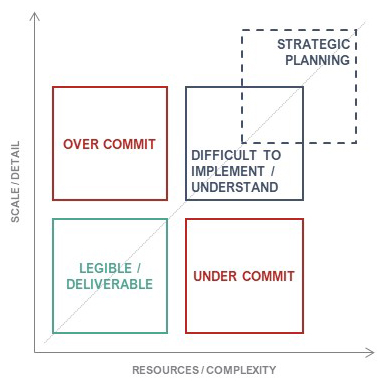Purpose and outcomes
NOPs can be beneficial and flexible but should be developed in a way that matches the local context, and analysis required to address the issues being faced.
NOPs can be beneficial and flexible. They have the potential to align a range of network planning, development and management activities and stakeholders. NOPs can also be applied in a number of ways, for a range of purposes, and in various settings and contexts. Given local context and needs vary, the level of detail, analysis and types of outputs required should also differ.
Some of the issues related to the use of NOPs are illustrated in the figure below.
NOP issues and implications
Successful NOPs match the scale and the resources needed to the detail and the complexity of the issue being addressed. If this is not achieved, there is a potential to over or under commit and not provide the best outcomes.
Some issues are too complex for NOPs. Where issues are highly complex, difficult to understand or require significant resourcing to solve, strategic planning based approaches should be considered, at least in the first instance.
Case Studies
NOP application varies between jurisdictions. This is a reflection of both the implementation stage they are at and the NOP’s core purpose and desired outcome.
An overview of the core purpose and desired outcomes reflected in the case studies is provided below.
Case study | Jurisdiction | Purpose | Output |
|---|---|---|---|
Western Australia | Provide a 'one stop shop' reference on the operation conditions of each route. | Their outputs have been used to assess the state road networks performance, inform proposed programs, prioritise works and help assess their implementation. | |
New Zealand | To effectively use the existing network in order to reduce costs and understand where certain prioritisation should occur. |
| |
New Zealand | To integrate planning and investment across the three levels of government - resulting in a ‘one-network’ approach to road network optimisation and management |
| |
Tasmania | Setting an agreed aspirational network arrangement. | Small-scale operation decision making (not a definitive source as yet) as part of projects and signal operations. | |
Warrigal Road Movement and Place – Intersection Operating Principles | Victoria | Guide the current operation along the signalised corridor. | A set of Intersection Operation Principles (IOPs) to guide how modal movements should be prioritised along the corridor. |

